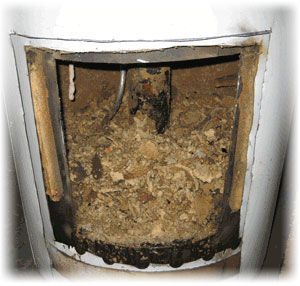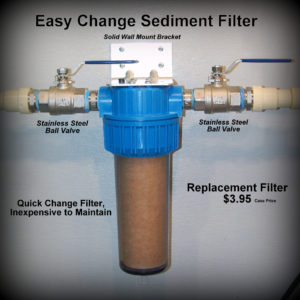If your water heater is full of sediment, it can be a real pain. The sediment can cause the water heater to overheat, and it can also clog the pipes leading to and from the water heater. There are a few things you can do to prevent sediment from building up in your water heater.
- Check the water heater for leaks and have any repairs made as soon as possible
- Inspect the anode rod and replace it if necessary
- The anode rod helps to prevent sediment from forming in the water heater
- Flush the water heater on a regular basis to remove any sediment that has already formed
- Install a sediment filter on the incoming water line to help prevent sediment from entering the water heater in the first place
How to Flush a Water Heater? | Flushing Will Probably Not Fix Your Problem
Why is There So Much Sediment in My Hot Water Heater?
If you’ve noticed an increased amount of sediment in your hot water heater, it’s likely because the unit is getting older and scale is beginning to build up inside the tank. While this isn’t necessarily a cause for alarm, it is something you should keep an eye on, as too much sediment can shorten the lifespan of your hot water heater.
Sediment is made up of minerals that are naturally found in water, like calcium and magnesium.
As water sits in the hot water heater tank, these minerals start to settle out of the water and cling to the walls of the tank. Over time, they can form a thick layer of sediment that insulates the bottom of the tank and prevents heat from being transferred efficiently. This can lead to higher energy bills and premature failure of the heating element.
Fortunately, there are a few things you can do to help reduce sediment buildup in your hot water heater. First, make sure that you’re using cold water when filling up the tank. Hot water dissolves minerals more quickly than cold water, so if you’re only using hot water to fill up your tank, sediments will start accumulating faster.
Second, flush out your hot water heater regularly (about once per year) to remove any accumulated sediment. Simply open up the drain valve at the bottom of the unit and let all of the Water run out until it’s clear again.
How Often Should You Drain Sediment from Water Heater?
If your water heater is starting to make strange noises, it’s time to check the sediment levels. Draining and flushing the tank on a regular basis will help to prolong its life and keep it running smoothly. But how often should you do this?
The frequency with which you need to drain your water heater depends on a few factors, such as the type of water in your area and the age of the unit. If you live in an area with hard water, for example, you may need to flush more often than someone with soft water. And if your unit is older, it may also require more maintenance.
As a general rule of thumb, most experts recommend draining and flushing your water heater once every six months. This will help to remove any sediment that has built up over time and keep your unit running efficiently. If you have hard water or an older unit, however, you may need to do this more often – perhaps even as frequently as once a month.
Draining and flushing your water heater is a simple task that anyone can do. Just be sure to follow the instructions in your owner’s manual carefully so that you don’t damage the unit. With just a little bit of care and attention, you can keep your water heater running like new for years to come!
How Do I Get Rid of Sediment Build Up in My Water Heater?
If your water heater is starting to show signs of sediment buildup, there are a few things you can do to clean it out and prevent further buildup. First, flush the tank by draining all the water out and then refilling it. This will help to remove any loose sediment that’s already in the tank.
Next, add a half cup of vinegar or lemon juice to the tank and let it sit for an hour before flushing again. This will help to break down any stubborn sediment that’s clinging to the sides of the tank. Finally, install a Sediment Trap on your incoming water line to help catch any sediment before it has a chance to enter your water heater.
By following these steps, you can keep your water heater free of sediment buildup and ensure that it runs efficiently for years to come!
How Do I Prevent Calcium Build Up in My Water Heater?
If you have hard water, there’s a good chance that over time, calcium deposits can build up inside your water heater. These deposits not only make your water heater less efficient, but they can also be dangerous if the deposits become large enough to block the flow of water through the tank.
Fortunately, there are a few things you can do to prevent calcium buildup in your water heater:
1. Install a Water Softener
One of the best ways to prevent calcium buildup is to install a water softener. A water softener works by removing minerals like calcium from your water before it ever enters your home.
This means that your water heater will never have to deal with hard water, and as a result, it will be much less likely to develop calcium deposits.
2. Use Vinegar or Lemon Juice periodically
Another way to prevent calcium buildup is to pour vinegar or lemon juice into your tank once every month or so.
The acidic nature of these liquids will help dissolve any small deposits that may have already begun to form on the walls of your tank. Just be sure to flush out the tank completely with clean water afterwards so that none of the acid remains in your plumbing system.

Credit: kennybunchplumbing.com
How to Dissolve Sediment in Water Heater
If your water heater has sediment in it, you may be wondering how to dissolve it. While there are a few methods you can use, we recommend using a mixture of white vinegar and water.
Start by mixing one part white vinegar with four parts water in a bucket.
Then, turn off your water heater and allow it to cool completely. Once it’s cooled, open the drain valve at the bottom of the unit and slowly pour in your vinegar mixture. Allow it to sit for an hour before turning on your water heater and flushing the system with fresh water.
If you have hard water, sediment can build up quickly in your water heater. This can lead to decreased efficiency and eventually premature failure. By dissolving sediment regularly, you can help extend the life of your water heater and keep it running smoothly for years to come!
How to Tell If Your Hot Water Heater is Full of Sediment
If your hot water heater is full of sediment, it’s important to know how to tell. Here are a few things to look for:
1. The water coming out of your faucets is discolored.
2. Your hot water heater makes strange noises.
3. Your energy bills have gone up unexpectedly.
4. There is rust on the exterior of your hot water heater.
If you notice any of these signs, it’s time to flush your hot water heater to get rid of the sediment. Sediment can build up over time and cause a number of problems, so it’s best to deal with it sooner rather than later!
How to Remove Sediment from Water
Sediment in water can come from a variety of sources, including runoff from agricultural fields, construction sites, and urban areas. Once sediment is in the water, it can be difficult to remove. This is especially true if the sediment has settled into the bottom of a reservoir or lake.
There are a number of methods that can be used to remove sediment from water, including:
-Dredging: Dredging is a process whereby sediment is removed from the bottom of a body of water using an excavating machine. This method is typically used to remove Sediment that has built up over time and is not easily removed by other means.
-Flushing: Flushing involves releasing large volumes of clean water into a body of water in order to scour away Sediment that has accumulated on the bottom. This method is often used in conjunction with dredging and can be effective at removing both suspended and settled Sediment.
-Barrier methods: Barrier methods involve creating physical barriers (such as dams or levees) that prevent Sediment from entering a body of water in the first place.
These methods are most effective at preventing Sedimentation before it occurs and are typically employed in conjunction with other mitigation strategies (like dredging).
Conclusion
If you have hard water, there’s a good chance that your water heater is full of sediment. Not only is this a nuisance, but it can also be dangerous. Sediment can cause your water heater to overheat and fail.
Fortunately, there are some things you can do to prevent sediment from building up in your water heater. First, make sure that you have a good water filter. This will help to remove any sediment that might be in your water before it has a chance to build up in your heater.
You should also drain your water heater on a regular basis. This will get rid of any sediment that has already built up in the tank. Finally, if you have an older water heater, consider upgrading to a newer model that has a self-cleaning feature.
This will help to keep your heater clean and free of sediment for years to come.

